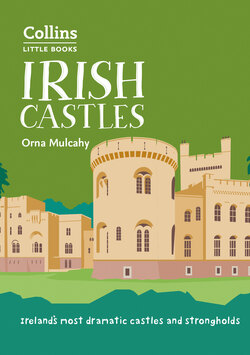Читать книгу Irish Castles - Orna Mulcahy - Страница 5
Introduction
ОглавлениеThere’s a special romance to Irish castles, whether it’s the ruined stronghold of an ancient Irish clan perched on a rocky clifftop, the monumental tower rising inside a town’s medieval walls, or the castellated fancy of a Victorian tycoon reflected in its own glassy lake.
Combined with the country’s dramatic scenery of craggy coastline, rolling green countryside, ancient woodlands, and loughs, Ireland’s most famous castles are set in dreamy locations beloved by generations of tourists, film-makers, and brides. Think of the majesty of ruined Dunluce, etched against the sky on the north Antrim coast; the thrilling bulk of Blarney Castle, home to the Blarney Stone, which is said to give those who kiss it the gift of fluent talk; or the splendour of Ashford Castle in Cong, County Mayo, the setting for film director John Ford’s sentimental tribute to Ireland, The Quiet Man, starring John Wayne.
It’s not known exactly how many castles dot the island of Ireland but it’s likely to be in thousands. A high number of fortifications reflect a rebellious history reaching back to the twelfth century and lasting all the way to the 1920s, when many of Ireland’s aristocratic homes were abandoned or burned during the War of Independence.
Ruins abound: fortresses destroyed by cannon fire tell of Cromwell’s rampage through Ireland in the late 1640s; the shells of once grand castles, built in prosperous times and then abandoned.
This book provides a guide to 140 or so Irish castles and strongholds, many of them dating back to Norman times and earlier, some of them far more recent, but all selected for their historical or architectural significance.
Some are ancient monuments, standing strong after nearly a thousand years; others mere piles of stones in once strategic settings. Many, like grand Malahide Castle on the outskirts of Dublin and Dublin Castle in the centre of the capital, have been carefully restored and are open to the public. Others can only be viewed externally and from a distance. One or two are twentieth-century replica castles, such as Doonbeg on the County Clare coast – now owned by US President Donald Trump.
Castles first appeared in Ireland with the arrival of the Anglo-Normans in the twelfth century. Land distributed by King Henry II of England was parcelled out to royalists who built fortified towers to protect themselves from the native clans. These castles were built in strategic positions, and consisted of a large square or rectangular tower, known as a keep, surrounded by a large curtain wall. Other defensive measures were a moat, portcullis and drawbridge, and battlements.
By the beginning of the thirteenth century, stone castles began to appear, many built on the orders of King John. Amongst the earliest of these is Dublin Castle, built in 1204. The fortifications of Carrickfergus in Antrim and Trim in County Meath (once known as the Royal County) also date from this period. By the middle of the century, castles had spread throughout Ireland, built by Anglo-Norman families, who quickly integrated themselves, marrying into native families and becoming Hiberniores Hibernis ipsis, meaning “more Irish than the Irish themselves”.
From 1400 onwards, native Irish chiefs began to build their own castles, adopting the tower house design, with battlements offering commanding views of their territories.
In 1429, Henry VI, King of England (and Lord of Ireland) granted ten pounds to any of his subjects who built a small defensive tower in the area surrounding Dublin – called The Pale – which included the counties of Meath, Louth, and Kildare. This resulted in a proliferation of “ten pound” castles of a fairly basic design, many of which survive today.
The Irish Rebellion of 1641 and the Confederate Wars that followed set the native Irish and old English Catholics against English Protestants and Scots Presbyterian planters in a bloody conflict through the land that saw castles seized and their occupants murdered. Cromwell’s invasion of Ireland in 1649, and subsequent conquest, quelled the rebellion with a swathe of violent conquests through the land that left many of Ireland’s castles either destroyed or confiscated and given to “planters” loyal to the English monarchy.
The 1700s saw a revival in building, with a move from the fortified tower to a more domestic style in architecture. Earlier castles were either incorporated into new country house designs or sometimes left at a distance from the new structure.
Throughout the eighteenth and particularly in the nineteenth century, many such properties were extended again, or replaced entirely, this time with the help of fortunes built in the great industrial cities of England or further afield.
The Victorian Irish had a penchant for castles, and this produced a proliferation of battlements, towers, and turrets added to homes originally built in the plain Irish Georgian style. Brand-new castles were built in the romantic style, from Kylemore Abbey in Connemara to the dramatic Glenveagh Castle in County Donegal.
But in the aftermath of the Irish Famine many estates were sold or broken up. The 1920s brought a further wave of unrest, with several great Irish homes being burned out by rebels during Ireland’s War of Independence.
Many of the castles featured in this book are open to visitors. Some operate as hotels or guest houses, while others can be viewed by appointment or on certain open days of the year. However some remain privately owned and their inclusion in this book does not imply a right of public access. It is always advisable to check with the specific attraction in advance. Telephone number and website, where available, are listed in the property description.
